.
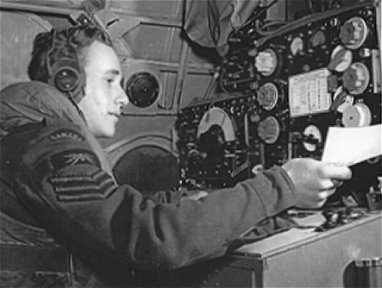
… ..- -. -..
. .-. .-.. .- .--
-.. .-. .- -.. ..
---
--- .--. . .-.
.- - --- .-. … .--.
--- … .. -
.. --- -.
Apologies to the Ags. Like riding a bicycle, WAGs never forget.
Charley
Yule submitted the following material on Halifax NA3 337
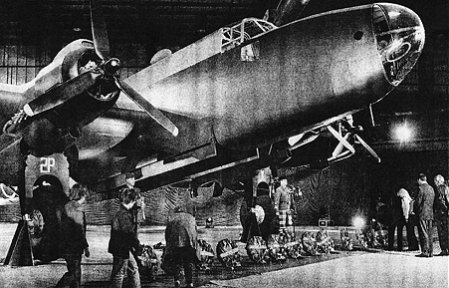
Guests place wreaths before restored Halifax NA337 unveiled
at Trenton Museum
Restoration of plane tribute to lost comrades
Allied forces flew 6,178 Halifax bombers during WWII
but few remain. One has risen from the bottom of a Norwegian lake to be
restored for unveiling at the Royal Canadian Air Force Memorial Museum,
Trenton, Ont.
By Natalie Pona ~ Toronto Star November 5, 2005
CFB TRENTON
Jacqueline Bastable was only six months old when her dad’s
World War Two plane plunged into the lake in Norway. So she never felt
like she knew her father – until yesterday. .That was when she saw her
dad’s aircraft for the first time, restored to look like it did before
the catastrophic night in 1945.
Bastable was at the Royal Canadian Air Force Memorial
Museum, 8 Wing Trenton, for the unveiling of the Halifax A MKV11, NA337.
Her dad, Walter Mitchell died when the plane was shot down by German anti-aircraft
gunners just two weeks before the end of the war. He was 22.
“This has filled a great big hole. I grew up not knowing
my father and my mother always found it too painful to talk about,” said
Bastable, 61, who came from England for the ceremony. “I think I
understand him a lot more … it’s the first time I can touch something my
father was in. It is the last place he was before he died.”
After taking off from the RAF base in England on April
23, 1945, their mission was to drop rifles, food, and clothes to Norwegian
Resistance Fighters. The plane was shot down by German ant-aircraft gunners
and crashed into Lake Mojosa. There was only one survivor (Tomas
Weightman, the tail gunner) in the crew of six. He was too frail to come
to the ceremony.
The NA 337 was pulled from the lake in1955 and restored
by a team of volunteers to its original state – one of only three planes
that remain .
“I can almost imagine my Dad as he took off… I can just
imagine him having that fear of knowing what he was going off to do,” Bastable
said. “this is a tribute to all the men who fought and flew in Halifaxes.
But for me, it’s also a memorial of my Dad. That’s the selfish side.”
Hundreds gathered at the museum today in memory of the
more than 10,000 RCAF personnel who died (in Bomber Command) during
World War II. When we were laying the wreaths and singing O’Canada, I couldn’t
sing, I choked up,” said Lloyd Wright, 84. He was a member of the restoration
team, who also piloted a different Halifax during the war. We were some
of the lucky ones, I lost a lot of good friends.”
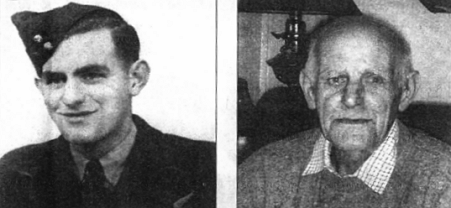
Tail Gunner Thomas Weightman then and now
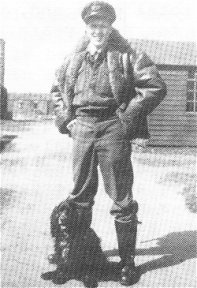
Ross Hamilton 407 Squadron with Blackie,
Sqdn. Mascot. Blackie flew Ops with crews.
Ross writes:
“One article in the January 2006 Short Bursts stirred
me to action, and that was about the Polish chap, Mark Oziewicz,
who escaped from his homeland and made it to England to join the RAF. “
Ross submitted the following article.
Jan Pidek escaped from Poland in 1939 at age 19 to avoid
the Nazi and Russian invasions. At the time he was taking his pilot training
at the Polish Air Force Academy but hadn’t fully graduated. His escape
odyssey took him to Romania then by ship to Transalvania, Beirut, Marseilles,
Caan and Paris, and finally to England.
Jan joined the RAF in April 1940 at Eastchurch, and began
his RAF training period after air-testing of his earlier schooling. Following
his SFTS graduation and obtaining his pilot’s wings, he was posted to No.
308 Polish Squadron at Hutton-Cranswick flying Spitfires. He was in time
to take part in a good many “ops” during he Battle of Britain, plus flying
cover for the Dieppe raid, up to and including the same on D-Day.
The Squadron subsequently moved to Caan in France, flying
support with the invasion forces. Jan remained with 308 Squadron in Belgium
on his second tour until the end o the war. He was then attached to the
RAF Occupational wing, in which three Polish Squadrons participated.
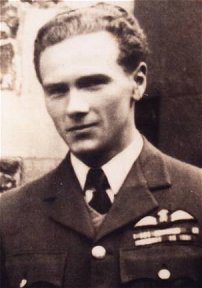
Jan Pidek 308 Squadron 1945
During his sojourn in Germany, Jan and his colleagues
made a point of visiting some of the newly liberated slave-labour camps,
where many of his countrymen and women were unwilling guests, in order
to distribute comfort items such as chocolate, food, etc., to the recently
liberated captives.
On one such visit he made the acquaintance of a very beautiful
young lady from his home country, and a romance soon blossomed. Jan and
his lovely Gizelle were subsequently wed in Germany on June 24, 1945.
Jan, with his new bride, returned to England in 1948 to
RAF Station Portreath, where he took his discharge from the RAF. He had
accumulated 1100 combat hours on Spitfires.
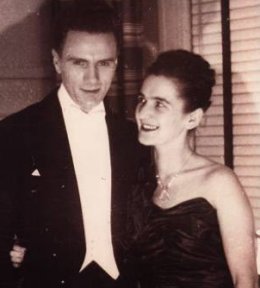
Jan and Gizelle 1948
|
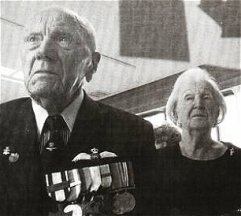
Jan and Gizelle Pidek
Kekowna B.C.
Photo taken by Gary Nylander
The Okanogan Sunday, September 25, 2005
|
Subsequently the Pideks migrated to Canada (Winnipeg) in
April 1948, where Jan was in private industry for ten years. He then accepted
a position with the Federal Government in Ottawa as Director of the Public
Archives, until his retirement.
In 2005 Jan and Gizelle left Ottawa and moved to Kelowna,
B.C., to be near his beloved niece, one of only a very few of his surviving
relatives. Jan is now 85 years of age, a member of our local “Wartime Aircrew”
club, and an honoured “Brother”. Long may this special couple be in our
midst.
Walter Shaw ~ Regina,
Sask.
One day whilst based at Aqir, Palestine, flying for Transport
Command, my two-man crew and myself found that we had run out of cigarettes
and there were none available on the base so we got the OK to fly up to
Lydda to purchase some. When we landed and purchased some fags we
were classed as people passing through and were entitled to a meal
So we ate a good breakfast (free) got back on our kite and returned to
base. (You would think we were politicians not paying for a meal)
But it was fun.
Regards....Walt
tubbyraf@accesscomm.ca
BOOKS
From Wings Parade to Mandalay
by Allan Coggon
300 pages soft cover. Many photos, illustrations, and
tactical maps.
ISBN 1-4120-6921-1
In Canada:
Trafford Publishing,
6E-2333 Government St.,
Victoria, B.C. V8T 4P4
Tel. 250.383.6864 or 1.888.232.4444
E-mail: orders@trafford.com |
In Europe:
Trafford Publishing (UK) Limited
9 Park End Street ,
2nd. Floor,
Oxford, UK. 0X1 1HH
E-mail: info.uk@trafford.com |
Allan Coggon takes the reader on a nostalgic, emotional
, mood swinging, coaster ride. From the exhilaration of obtaining his wings
in 1940, and dreams of fighter pilot status, to the deflation of being
posted to an Instructor’s course. In 1944, his desire to serve overseas
is finally fulfilled when he put in a tour on 31 Squadron RAF over the
jungles of Burma. The mood changes to sombre realization of the trauma
of conflict.
While serving in Canada as a staff pilot the author provides
the reader with much gallows type humour. It seems that on the home front
aircraft maintenance was sometimes of a low priority due to shortage of
spare parts. In one case an inventive mechanic, because the stores was
out of copper fuel lines, used the rubber tube off a douche bag. The engine
test and flight test went well. However, when the author took the aircraft
up for a night transport flight, after two hours both engines stopped.
It took that long for the high octane fuel to eat through the rubber. Many
ex-aircrew readers will identify with the problems encountered in Canadian
flying.
The Burma campagne has been known as ‘The Forgotten War’.
In his preamble to the Burma section of his book the author states:
“My account of the war in Burma
is a brief account of the adversaries in the longest continual battle in
the Second World War, and Britain’s longest retreat. It is not presented
as an objective or exhaustive account of the Burma campaign. The prologue
and the nine vignettes are meant to refresh the memories of those whose
recollections may be hazy and for those who were not yet born. Consequently,
some aviation enthusiasts may find themselves in a holding pattern with
my geographical, cultural, and special unit descriptions as a preamble
to the flying activity. Nevertheless, my flight plan in documenting these
details some 60 years later is to inform those who never knew of
“The Forgotten War”.
Some times supplies were ‘kicked’ out over a
drop zone (DZ). When the enemy were close to the DZ the pilot had to fly
over enemy positions at 500 feet to approach the area. As the window of
drop was often small, the pilot had to make a number of circuits to deposit
the full load. In other cases when they put down on temporary landing strips.As
the area changed hands so quickly they didn’t know for sure which side
controlled the strip. Often on landing, the crew would run from the aircraft
to the closest slit trench until the aircraft was unloaded. Their main
concerns were enemy Oscar fighters, ground fire, mountains, and the violent
unpredictable weather.
It is true that there were many different types of air
war. Bomber Command flew in their steams of hundreds of planes and many
crashed on the continent; Coastal command crews went out individually as
did Ferry Command crews. When they didn’t return or reach their destination
it was often, ‘Lost at Sea’. Allan Coggon describes another military experience.
When supply aircraft that went down, whether from enemy fire, or violent
storms, the jungle claimed them, and for many crews, guards its secrets
to this day.
I found this a most fascinating read. It is well documented
and supported by tactical maps. It is a book that should be in public and
school libraries.
Reviewed by John Moyles
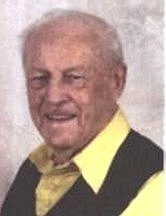 |
Author Allan Coggon spent 38 years as an active pilot,
obtaining his wings with the RCAF in 1940, serving in Eastern Canada until
1943, and then doing a tour with the RAF against the Japanese forces in
South East Asia. After completing his tour of 700 hours with 31 Squadron,
the author retuned to Canada and, following his discharge, continued
a career in flying. First with the KLM Dutch Royal Airlines on trans/oceanic
and intercontinental flights to Dutch East Indies. He then flew with Hollinger
Ungava Transport; personal pilot to Sir James Dunn in St. Andrews, New
Brunswick; Algola Steel Corporation, Sault Ste Marie, Ontario; instructed
on ski and float planes in the hinterland north of Lake Superior. In 1992
he was instrumental in forming the Nova Scotia branch of the Aircrew Association
and in 1992, the Silver Dart Chapter of the Canadian Aviation Historical
Society in 1096. |
CORRESPONDENCE
Dear Sir:
I have been trying to find out where exactly the
Blister gunner was on three Halifaxes 0f 10, 77 and 78 sqdns. who reported
combats with e/a on the Plzen raid of 1943. It is definitely the nose position
for the V.G.O. gun. I suspect it is was on the floor of the aircraft. even
better would be a photo of the position! These were MKII Halifaxes at least
one of which had to Z Fairing on the nose.
Can any air gunners help?
http://mysite.wanadoo-members.co.uk/pilsen_raid_1943/index.jhtml
Peter Cunliffe
Editor’s reply:
Greetings P Cunliffe,
(Pretty heavy on the Sir, might go to my head)
Regarding your question, I published a picture
of the waist gunner's position in the Halifax in one of our mail-out newsletters
prior to March 2001. I will try to find it and send you a copy.
Cheers,
John Moyles - Editor of Short Bursts
Peter’s reply.
Thanks for your efforts my original should have read
as below! Must have typed it late night.
It is definitely NOT the nose position for the V.G.O.
gun. I suspect it is was on the floor of the aircraft. even better would
be a photo of the position! I talked to a ex Bomber command pilot on Halis
and he said they had a position on the floor for a blister. It is amazing
how hard it is to find someone who knows!
Peter
pwc@accycunliffes.fsnet.co.uk
Memories
Hi, Came across your site while surfing around. My age
is 86 and I live in Stoke on Trent, England. During the war years I was
a bus conductress, and often had airmen travelling on my bus between Derby,
Uttoxeter and Hanley Stoke on Trent.
There was an airfield at Foston close to Uttoxeter it
was upsetting to see the planes covered with tarpaulin, after a raid. Many
friendly chats were exchanged, but one in particular I remember was with
a young airman whose home was in South Africa. On one of my early morning
trips he boarded my bus at Cheadle, which is near to Uttoxeter; he told
me he had hitch hiked from Derby the previous night to visit his young
brother at nearby Denstone college. I thought how very thoughtful of him
and prayed that he would return safely home. My husband served with the
Royal Tank Regiment in the middle east and in Europe. He was slightly wounded
while disarming German soldiers at the Danish border. With Regards,
Eveline Shore
Southern Alberta group changed Contact
Person and President to:
Larry Robinson
Box 179, Okotoks, AB. T0 L 1T0
Ph: (403) 938-4105
Karl Kjarsgaard
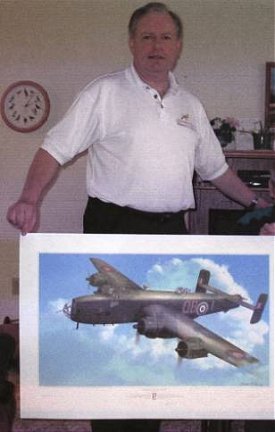
I have attached a photo that would be important for those
interested in buying our Halifax print "INVINCIBLE ITEM".
The print sales are the main source of the success of
our Halifax Project at this time.
I am hopeful to hear from the Alberta government in early
2006. about our request for financial support.
I have included a picture of Russell Earl and myself when
he was signing the prints in Estevan in early Dec.
This also gives people an idea of the size and quality
of the print, it is one of the best in years with 11 signers who actually
flew our LW170 in combat, a real collectible.
The signed ones are ($ 165. including postage)
The unsigned are ($90 including postage).
Thanks for your support in 2005 and wishing to "Press
on regardless .." with you and the AG's in 2006.
Regards,
Karl
Editor: the picture Karl
sent also included Russell Earl but I was unable to download the full picture.
Sorry Earl, we will get you in later.
From Bill Hillman
Google Earth
menaced by WW2 bomber
Veteran aircraft caught in flight over UK
By Lester Haines ~ January 9, 2006
The results of our Google Earth black helicopter competition
last year proved just how eagled-eyed you lot were when it came to virtual
plane spotting, but here's one you missed, and a real blast from the past
it is too:
Check out: http://www.theregister.co.uk/2006/01/09/google_lancaster/
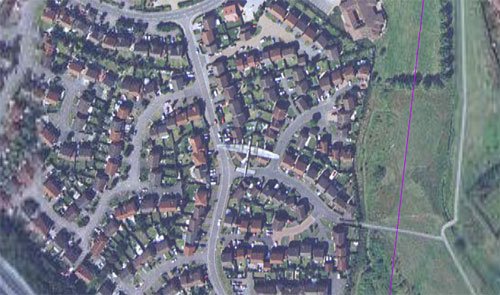
Hello,
There doesn't seem to be a list of rcaf servicemen from ww2.
A bomber crewman (ray reeder) from swift current went to
europe and retured safe after the war, but I can't find
any mention of his name or squadron. any suggestions.
Thanks
John Lutes . . .Moncton
Editor: Through 411 service I contacted the only Ray
Reeder in Swift Current but he said that he was not in service during WWII.
Does the name ring a bell with any of our readers? The Swift Current, SK.
Legion might be a starting point.
HELL’S ANGELS
30rd Bomber Group (H) Association.
Missing Comrades Register
Below are the names of nearly 5,000 303rd BG(H) Comrades
for whom we have no current information. We are looking for address information
if they are living, or a death date if they are deceased. Please help us
in our search. If you have ANY information about anyone on the list, please
contact: missing@303rdbg.com. Please see our Lost Comrade Search Tips.
See: http://www.303rdbg.com/missing4.html
Honouring
the Memory of Winnipeg’s Andrew Mynarski, V.C.
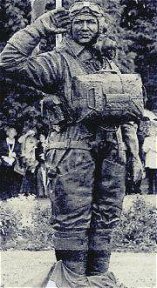 June
13, 1944.
June
13, 1944.
In an instant frozen forever in time, a young airman,
wrapped in flames, turned back to his trapped comrade in the stricken Avro
Lancaster bomber and snapped a salute. For precious moments, he had struggled
with the doors of the jammed tail gun turret while the fires that consumed
his clothes and parachute, and, eventually his life, sealed the fate of
the bomber and its crew.
Fifty years later, at the bomber base in England where
he served, a larger-than-life bronze statue of Pilot Officer Andrew Mynarski
was recently dedicated. His selfless act won him the Victoria Cross, Canada’s
highest tribute for valour in peace and war. Today, his hometown is mobilizing
to remember its North-End hero by bringing an exact copy of the Mynarski
statue home to Winnipeg.
One year ago, Middleton St. George in England began the
“Forgotten Hero” appeal (as part of the Wartime Memories Project) to honour
the memory of the Victoria Cross winner. The local newspaper, The Northern
Echo and the Winnipeg Free Press were instrumental in the fund-raising
that eventually saw donations from Canada, the United Kingdom and other
parts of the world flow into this small town in Northern England.
A group of local Winnipegers prominent in business, government,
heritage, military and community organizations have now embarked on a fund-raising
project to raise $60,000+ to cast a new statute by Keith Maddison, the
original sculptor of the Mynarski memorial at Middleton St. George. The
Mynarski Statue Project has the cooperation and support of the Andrew Mynarski
V.C. School, the 573 Andrew Mynarski Air Cadet Squadron, the Canadian Aviation
Historical Society, the Manitoba Aviation Council and the Polish Combatants
Association, among a host of other organizations committed to the goal
of bringing the Mynarski Statue home.
Fund-raising has just begun, with all funds directed to
Jim Bell, President of the local chapter of the Canadian Aviation Historical
Society, c/o 1 Allen Dyne Road, Winnipeg, MB, R3H 0Z9, (204) 774-2580 or
mbavn@mts.net
Completing the Circle - Remembering Andrew Mynarski
today
The story of “Andy” Mynarski is also the story of a North-End
Winnipeg hero; today, a school, park and an Air Cadet Squadron bear his
name. On Remembrance Days, his story is recounted as a tale of individual
courage, but it is much more than that, it is a story as timeless as his
heroism, it is a story of a community, of Polish immigrants, of young men
who went off to war and the generation of today that still needs to know
his story.
To see a more detailed account go to 2005 Short Bursts
Page: www.hillmanweb.com/rcaf/mag/0511.html
With the completion of Canada’s “Year of the Veteran,”
the imminent 50th Anniversary of Andrew Mynarski VC School and the Forgotten
Hero Appeal at Middleston St. George, a fitting tribute to a wartime hero
is appropriate and now we have the opportunity to do just that.
Our Goal:
• Community awareness of the Andrew Mynarski story
• Creating a partnership of various individuals and organizations
for planning and action
• Funding the costs of mold repair and casting of a Keith
Maddison sculpture (£30,000)
• Casting an exact duplicate of the Andrew Mynarski statue,
in England
• Funding any associated costs of repair, casting and
travel of the Mynarski statue
• Transporting and installation of the statue at a suitable
site in Winnipeg
Our Partners:
• • 419 Sqdn, Canadian Armed Forces
• 500 Wing City of Winnipeg
• 573 Andrew Mynarski Air Cadet Sqdn
• Dr. Tom Axworthy
• Andrew Mynarski V.C. School
• CAF- Heritage and History Branch
• Canadian Aviation Historical Society
• Canadian Warplane Heritage Museum
• Harry Lazarenko, Wpg City Councillor,
• Historica
• Keith Middleton, Sculptor
• Bonnie Korzeniowski, MLA
• Manitoba Aviation Council
• Middleton St. George Primary School
• The Northern Echo newspaper
• Polish Combatants’ Association
• Royal Canadian “Polish” Legion #34
• Judy Wasylycia-Leis, MP
• Wartime Memories Project, U.K.
• Wartime Pilots’ and Observers’ Association
• Western Canada Aviation Museum
• Winnipeg Free Press
I invite you to join us.
Bill – in my other life, a meek and mild librarian
– Zuk (204) 294-2289 mbavn@mts.net
Prince George Duke of Kent
20 Dec. 1902 – 25 Aug. 1942
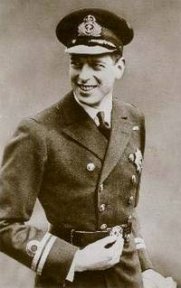
Dear John,
Firstly, let me take this opportunity of wishing your
wife and yourself a Happy New Year. I hope you’re both well. I’ve
just looked through the last few issues of Short Bursts and, as usual,
they’re difficult ‘to put down’, so to speak.
Let me bring you up to date. After over a year’s research,
I believe I will have enough material for a fairly detailed biography of
the Duke; (of Kent) it will, of course, include what I hope will be the
most detailed and accurate account of the events surrounding the tragedy
in 1942, but a biography should have a wider appeal than a book dealing
solely with the loss of W4026. I still have a lot of work to do, and every
day I make a new contact and learn something more. Only yesterday I was
put in touch with a journalist in Pembroke, John Evans. He has his own
publishing firm, Paterchuch Publications, and has written several books
about Pembroke Dock (PD) during the War and the history of the Sunderland.
He was recommended by a wonderful eighty-five-year old, Eric Harrison,
who is Secretary of the 228 Squadron Association. He is amazingly active
and still a dynamic member of his local Rotary in Manchester. He served
as a navigator on Sunderlands and has given me a great deal of information
and assistance.
It may be that you already know of John Evan’s books,
which include the official history of 228 Squadron, but if not, I feel
sure they would be of interest to you and your colleagues. You might like
to have a look at his website: www.paterchurch-publications.co.uk. I’ve
given him details of your website. His e-mail address is: johnevans@paterchurch.freeserve.co.uk
I’m about to write again to Don and Jack, who’ve been
so helpful, as after re-reading my notes, there are some points I would
like to check with them. I do hope they’re both well.
I wonder if you or one of your colleagues could help me
with a small point. The Duke’s ADC on the fateful flight was the Hon. Michael
Strutt; he was 28. I know a lot about him, but in brief he was the son
of Lord Belper, a Derbyshire industrialist. After university Michael went
into business in New York. In July 1939 he married an American in Newport,
R.I. By 1941 he was an air gunner on a Lancaster based at Mildenhall. What
puzzles me is that the records at the Commonwealth War Graves Commission
show that at the time of his death not only was Strutt a Pilot Officer
(Air Gnr.) in the RCAF serving in 228 (RAF) Sqdn., but that he was also
a Canadian citizen. His service number was J/15062. I have asked my father
about this and he relates that before the USA entered the War, it was not
unusual for Americans who wanted to serve in the RAF to go over to Canada
to join up. I wonder whether Strutt, being marooned in New York in
September 39, joined the RCAF for this purpose. If so, would it have been
necessary for him to become a naturalized Canadian?
Does Canada have an equivalent to the London Gazette,
the British Government’s official newspaper, which publishes all commissions
in the Armed Forces and naturalizations? (The Gazette for the whole of
the Twentieth Century is available on-line.) I’m sorry to trouble you with
this query, but it’s been puzzling me for months!
Best wishes,
Glyn
Karim Gaafar hugo-pacha@telefonica.net
P.S. During his 1941 tour of Canada, the Duke, while travelling
with the Premier of Ontario, was in a nasty car crash. Luckily, neither
of them was badly hurt. I think the Duke must have been driving: he hated
chauffeurs and drove himself everywhere. Unfortunately, he was a keen but
reckless motorist and crashed often!
Glyn -
Michael Strutt enlisted in the RCAF. His RCAF service
card indicates
Citizenship: Eng
He trained at No. 1 Bombing and Gunnery School, Jarvis,
Ontario Canada.
I have attached a copy of this email to Robert Schweyer,
a good friend and author of an excellent book about No. 1 Bombing and Gunnery
School. Rob has researched the visit of the Duke of Kent to Canada/Jarvis
as well.
I have some photos of the Duke of Kent visiting RCAF Trenton
which I can scan and email to you.
Sincerely,
Wally Fydenchuk wpf13@hotmail.com
Editor: The above Duke of Kent photo came from http://en.wikipedia.org/wiki/Prince_George%2C_Duke_of_Kent#Death
There is an interesting quote regarding a conspiracy
theory.
From: Leonard A Estrella Jr.
LennyEstrellaJr@cox.net
To: hillmans@westman.wave.ca
Sent: Sunday, January 22, 2006 5:53 PM
Subject: 407 Demon Sqd.
Hi my uncle Leonard W Almquist flew a Hudson in WW2.
He was in the 407 Demon Sqd. His plane went down Dec 15, 1941 over the
Dutch coast. I was wondering if any one served with him or knew him. Please
contact me
Mr. Leonard A Estrella Jr
LennyEstrellaJr@cox.net

Lockheed Hudson
Subject: Summer Event
at Nanton Alberta.
Good morning John.
I have just received an e-mail from Bob Evans at the
Nanton Lancaster Museum and he informs me that the date of the 20th Anniversary
of the Museum in 2006 is changed from August 19 to August 26. You
might want to include that in the next issue of Short Bursts. I will
have something for you shortly. I have the photos and most of the information
on the Edmonton Aviation Heritage Museum, I just have to put it all together
and send it to you.
Ted Hackett
Editor’s Report
The picture of Ross Hamilton with the Squadron mascot sent
me to the old Short Bursts Newsletters where I found in Issue #39, September,
1992, the following:
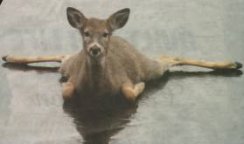 Then
there was the fawn (baby deer to city dwellers) that frequented the Sgt’s
lounge at 7 BR Squadron. The chaps poured beer into ashtrays and our mascot
kept the trays squeaky clean.
Then
there was the fawn (baby deer to city dwellers) that frequented the Sgt’s
lounge at 7 BR Squadron. The chaps poured beer into ashtrays and our mascot
kept the trays squeaky clean.
As the evening wore on the little
free loader had difficulty navigating and its spindly undercarriage kept
retracting. Something like the accompanying picture.
It is said that laughter is the
best medicine, and believe me, at our age we need all the support
we can get. Send in your anecdotes and stories, give the chaps a chuckle,
We will be back in March.
Keep well.
John & Doreene Moyles.
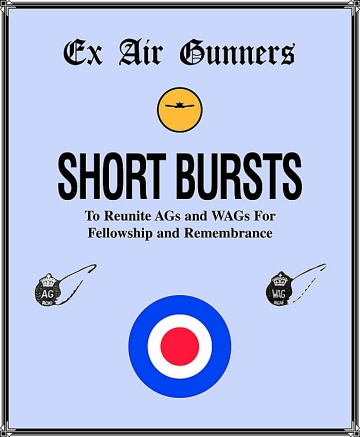







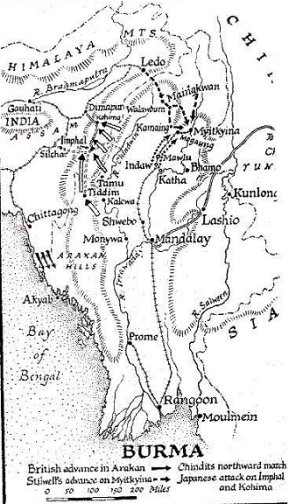
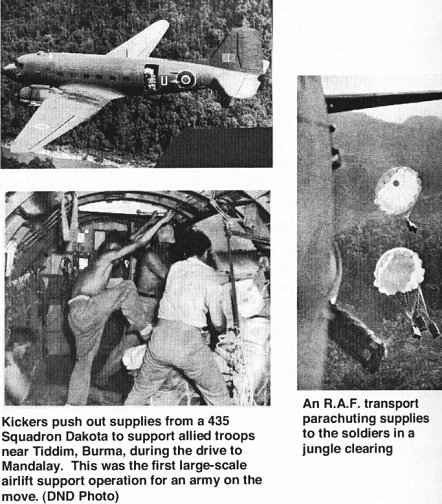



 June
13, 1944.
June
13, 1944.


 Then
there was the fawn (baby deer to city dwellers) that frequented the Sgt’s
lounge at 7 BR Squadron. The chaps poured beer into ashtrays and our mascot
kept the trays squeaky clean.
Then
there was the fawn (baby deer to city dwellers) that frequented the Sgt’s
lounge at 7 BR Squadron. The chaps poured beer into ashtrays and our mascot
kept the trays squeaky clean.
